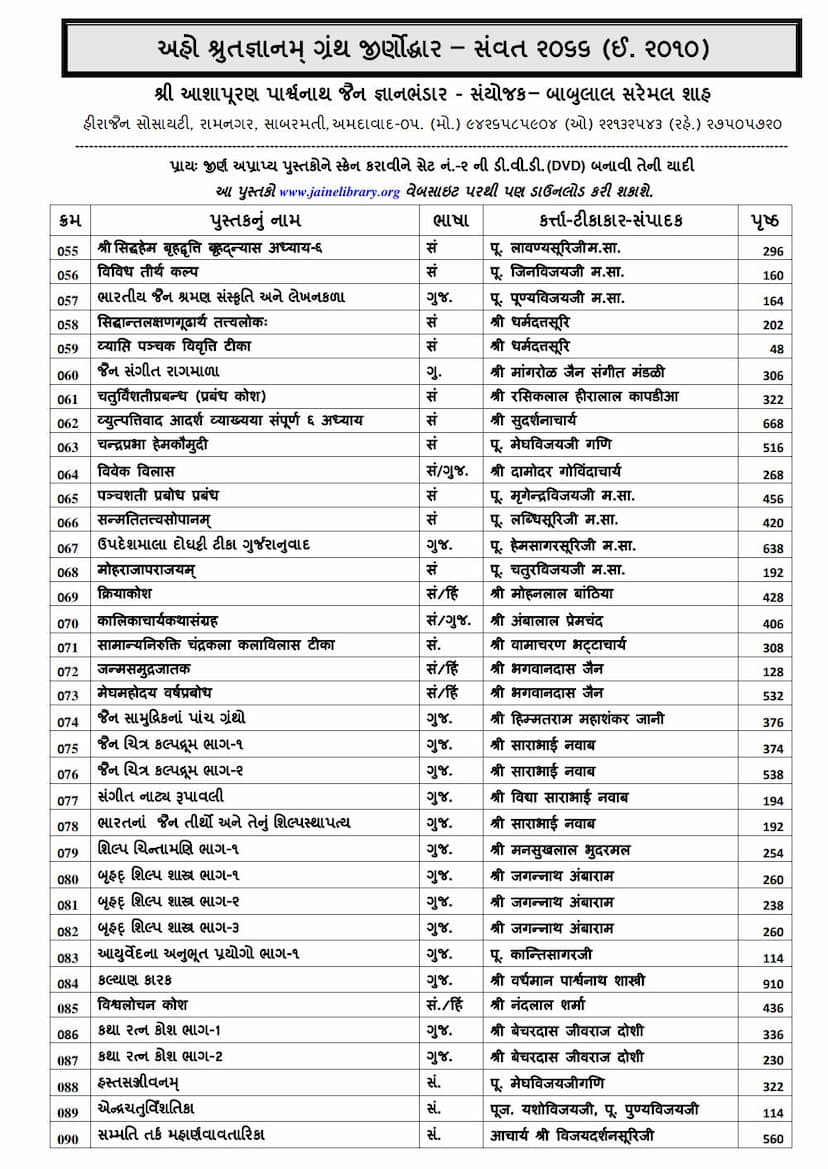Moharajaparajayam
Added to library: September 2, 2025

Summary
Here's a comprehensive summary of the Jain text "Moharajaparajayam," based on the provided information:
Title: Moharajaparajayam (The Overcoming of King Moha) Author: Yasahpala Editor: Muni Chaturvijayaji Publisher: Central Library, Baroda Publication Year: 1918 (as part of the Gaekwad Oriental Series)
Overview: "Moharajaparajayam" is a five-act allegorical drama that narrates the conversion of King Kumarapala of Gujarat to Jainism and his subsequent efforts to uphold Jain principles. The play is significant for its philosophical depth, its personification of abstract qualities as characters, and its historical context, offering insights into the religious and social milieu of Gujarat during the Chaulukya period.
Key Themes and Plot Summary:
The play's central narrative revolves around the moral and spiritual transformation of King Kumarapala, guided by the great Jain scholar and monk Hemachandra. The drama uses allegorical characters to represent virtues and vices, making the abstract concepts of spiritual struggle tangible.
Act-wise Summary:
-
Act I: Introduction and Setup
- The play opens with introductions and a prelude involving the stage manager and his wife, setting the context for the drama.
- King Kumarapala enters, expressing gratitude towards Hemachandra.
- A spy named Jnanadarpan reports on the movements of the enemy, King Moha, and his forces.
- The narrative introduces the concept of the struggle between righteousness (represented by King Dharma and his allies) and unrighteousness (represented by King Moha and his vices).
- Jnanadarpan's report details the initial stages of conflict and the allegorical personification of Moha's destructive influence.
-
Act II: The Influence of Virtue and the King's Dilemma
- Ministers discuss the need to overcome Moha, emphasizing the importance of Kumarapala's marriage to Krupasundari, the daughter of Vivekachandra.
- Kumarapala, influenced by Hemachandra's teachings, exhibits a growing inclination towards Jainism, abstaining from certain practices.
- The king's attraction to Krupasundari is depicted, alongside the Queen's displeasure.
- The act highlights the internal struggle and the influence of divine guidance (represented by Hemachandra) in navigating moral choices.
-
Act III: The Marriage and the Abolition of Harmful Practices
- The Queen's jealousy and her attempts to sabotage the king's virtuous path are shown.
- A significant event occurs when the king encounters a wealthy merchant, Kubera, who is presumed dead. This leads to the king's contemplation of the impermanence of wealth and life.
- The king learns about Kubera's virtuous life and vows concerning wealth management, reinforcing his commitment to ethical principles.
- The king ultimately abolishes the practice of confiscating the property of those who die heirless, demonstrating his adherence to righteous governance, influenced by Jain teachings.
- The marriage of Kumarapala and Krupasundari is arranged, symbolizing the union of virtue and righteous rule.
-
Act IV: The Manifestation of Vices and the King's Resolve
- This act delves deeper into the allegorical representation of vices.
- Characters like Gambling (Dyuta), Lust (Kama), Anger (Krodha), Greed (Lobha), and others are depicted as forces allied with Moha.
- The king's ministers and advisors, notably Punyketu and Vivekachandra, strategize to combat these vices.
- The king is shown to be actively working towards purging his kingdom of these negative influences, aligning with the twelve vows of a Jain layman.
- The play illustrates the king's growing awareness and condemnation of vices like theft, adultery, and even concubinage, though the latter is treated with some leniency by the king.
-
Act V: The Final Confrontation and Victory of Righteousness
- The play culminates in the direct confrontation between King Kumarapala (representing righteousness and Jain principles) and King Moha (representing vices and unrighteousness).
- Hemachandra's spiritual and practical guidance (through the Yogasastra and divine pills) equips Kumarapala for this ultimate battle.
- The allegorical battle features personifications of virtues and vices clashing. King Moha and his forces, including vices like Anger, Greed, and Pride, are ultimately defeated by Kumarapala, who embodies wisdom, non-violence, and righteousness.
- The play ends with Moha's defeat, Kumarapala's establishment of a just and virtuous kingdom based on Jain principles, and the lasting influence of Hemachandra's teachings.
Characters:
The play features a blend of historical and allegorical characters:
- Historical: King Kumarapala, Hemachandra, Vivekachandra, Punyketu, Moha.
- Allegorical: Vices like Moha, Kama, Krodha, Lobha, Anger (Raudrata), Gambling (Dyuta), Lust (Madanadeva), etc., and Virtues represented by allies of righteousness.
Author and Date:
- Author: Yasahpala, son of Dhanadeva, belonging to the Modha Bania caste. He was a minister and possibly a governor in Tharad during Ajayapala's reign.
- Date of Composition: Approximately between A.D. 1229 and 1232, during the reign of Ajayapala, the successor of Kumarapala.
Literary and Historical Significance:
- Allegorical Drama: The play is a pioneering work in Sanskrit literature for its extensive use of allegorical characters, similar to later works like the "Prabodhachandrodaya" and Western morality plays.
- Hagiography of Hemachandra: It serves as a testament to Hemachandra's profound influence on King Kumarapala, showcasing the king's conversion and patronage of Jainism.
- Social and Religious Insight: The play provides valuable information about the social customs, religious practices, and moral concerns of the period, including the prevalence of gambling, the status of women, and the ethical dilemmas faced by rulers.
- Historical Accuracy: While allegorical, the play is grounded in historical events and figures, offering a narrative framework for Kumarapala's reign and his association with Hemachandra.
Manuscript Material:
The edition is based on three manuscripts (A, B, and C), with A being a complete paper manuscript and B and C being incomplete palm-leaf manuscripts of varying ages and conditions.
Conclusion:
"Moharajaparajayam" is a significant Jain text that masterfully combines allegory, history, and philosophy to illustrate the path to spiritual liberation through adherence to righteous conduct and the teachings of Jainism. It highlights the transformative power of true knowledge and virtuous leadership, as exemplified by King Kumarapala under the guidance of Hemachandra.